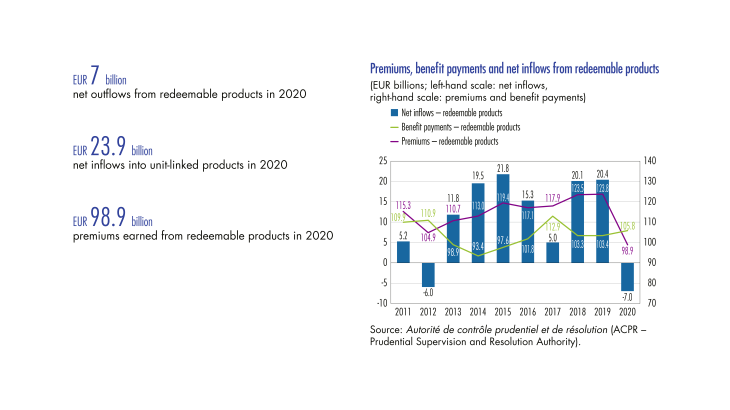1 The French life insurance market showed its resilience during the crisis
Life insurance in France: a long term savings product
Life insurance is a long term savings product available in various forms:
• Funds invested in euro denominated instruments with a capital guarantee and interest accrued upon payment. These funds make up a major part of the investments of French households (Banque de France, 2021a) and are the leading savings product in France ahead of interest bearing bank deposits. They account for 38% of household financial wealth.
• Funds invested in unit linked products for which the insurer guarantees the number of units only, and not their value. The risk that market values may fluctuate is borne by the policyholder, i.e. the insured.
• More recently, multi product policies under which part of the funds can be invested in a euro denominated product with the remainder invested in a range of financial assets (unit linked type instruments).
Many savers have life insurance (39% of households in metropolitan France in 2018 according to the Institut national de la statistique et des études économiques – Insee, 2018). However, life insurance policies are becoming increasingly concentrated among those with higher incomes – in 2015, the 10% of households with the highest incomes owned almost 80% of the funds invested in life insurance (Arrondel and Coffinet, 2019).
Despite the unprecedented impact of the health crisis on economic activity and markets, insurance companies were not weakened
The response of most governments to the Covid 19 epidemic included restrictions that impacted economic output. Global activity thus contracted by 3.5% in 2020 according to the International Monetary Fund (IMF, 2021). In France, the Banque de France estimates that GDP contracted by 8% in 2020 and that activity will return to pre Covid levels at the end of 2021 (Banque de France, 2021b).
In this unfavourable and uncertain environment, stock market values fell sharply at the beginning of 2020, heightening volatility in the equity markets. Indeed, after peaking at 6,111 points on 29 February 2020, the CAC 40 endured a dramatic correction, crashing to 3,754 points on 18 March. However, this correction was short lived and the economic turmoil prompted by the health crisis was not compounded by a financial crisis, thanks notably to the support measures taken by national and European authorities.
[to read more, please download the article]
